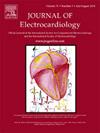在保留射血分数的心力衰竭患者中,aVR导联T波阳性与左心房和心室功能及心脏结局相关
IF 1.3
4区 医学
Q3 CARDIAC & CARDIOVASCULAR SYSTEMS
引用次数: 0
摘要
背景:保留射血分数的心力衰竭(HFpEF)占心力衰竭病例的很大比例,并与高发病率和死亡率相关。虽然超声心动图在HFpEF评估中发挥着核心作用,但心电图(ECG)结果的预后价值,特别是aVR导联的预后价值仍未得到充分探讨。本研究探讨心室导联T波阳性(TaVR)与左房(LA)、左室(LV)功能的关系及其对HFpEF患者预后的意义。方法本回顾性研究纳入231例根据ESC指南诊断的HFpEF患者。患者接受全面超声心动图和12导联心电图评估。aVR导联t波振幅≥1mm为TaVR阳性。利用LA水库应变(LASr)和LV全球纵向应变(GLS)分别评价了LA和LV的功能。采用多变量Cox回归和Kaplan-Meier生存分析来评估TaVR的预后意义。结果34.6%的患者TaVR呈阳性,与LASr(15.02±6.65% vs. 17.78±9.10%,p = 0.023)和LV GLS(- 13.66±3.49% vs. -15.19±3.02%,p = 0.001)受损相关。TaVR阳性独立预测1年全因死亡率(HR = 6.02, p <;0.001)和6个月全因死亡率(HR = 9.67, p <;0.001)。TaVR阳性患者住院率较高,临床预后较差。结论TaVR阳性与HFpEF左室功能障碍、左室重构及预后不良有关。将该心电图参数纳入常规临床评估,可加强风险分层,指导HFpEF患者的治疗策略。本文章由计算机程序翻译,如有差异,请以英文原文为准。

Positive T wave in lead aVR is associated with left atrial and ventricular function and cardiac outcomes in heart failure patients with preserved ejection fraction
Background
Heart failure with preserved ejection fraction (HFpEF) accounts for a significant proportion of heart failure cases and is associated with high morbidity and mortality. While echocardiography plays a central role in HFpEF assessment, the prognostic value of electrocardiographic (ECG) findings, particularly in lead aVR, remains underexplored. This study investigates the relationship between a positive T wave in lead aVR (TaVR) and left atrial (LA) and left ventricular (LV) function, as well as its prognostic significance in HFpEF patients.
Methods
This retrospective study included 231 HFpEF patients diagnosed according to ESC guidelines. Patients underwent comprehensive echocardiography and 12‑lead ECG evaluation. Positive TaVR was defined as a T-wave amplitude ≥1 mm in lead aVR. LA and LV functions were assessed using LA reservoir strain (LASr) and LV global longitudinal strain (GLS), respectively. Multivariate Cox regression and Kaplan-Meier survival analyses were performed to evaluate the prognostic significance of TaVR.
Results
Positive TaVR was observed in 34.6 % of patients and was associated with impaired LASr (15.02 ± 6.65 % vs. 17.78 ± 9.10 %, p = 0.023) and LV GLS (−13.66 ± 3.49 % vs. -15.19 ± 3.02 %, p = 0.001). Positive TaVR independently predicted 1-year all-cause mortality (HR = 6.02, p < 0.001) and 6-month all-cause mortality (HR = 9.67, p < 0.001). Patients with positive TaVR had higher hospitalization rates and worse clinical outcomes.
Conclusion
Positive TaVR is associated with LA dysfunction, LV remodeling, and poor prognosis in HFpEF. Incorporating this ECG parameter into routine clinical assessments could enhance risk stratification and guide management strategies for HFpEF patients.
求助全文
通过发布文献求助,成功后即可免费获取论文全文。
去求助
来源期刊

Journal of electrocardiology
医学-心血管系统
CiteScore
2.70
自引率
7.70%
发文量
152
审稿时长
38 days
期刊介绍:
The Journal of Electrocardiology is devoted exclusively to clinical and experimental studies of the electrical activities of the heart. It seeks to contribute significantly to the accuracy of diagnosis and prognosis and the effective treatment, prevention, or delay of heart disease. Editorial contents include electrocardiography, vectorcardiography, arrhythmias, membrane action potential, cardiac pacing, monitoring defibrillation, instrumentation, drug effects, and computer applications.
 求助内容:
求助内容: 应助结果提醒方式:
应助结果提醒方式:


